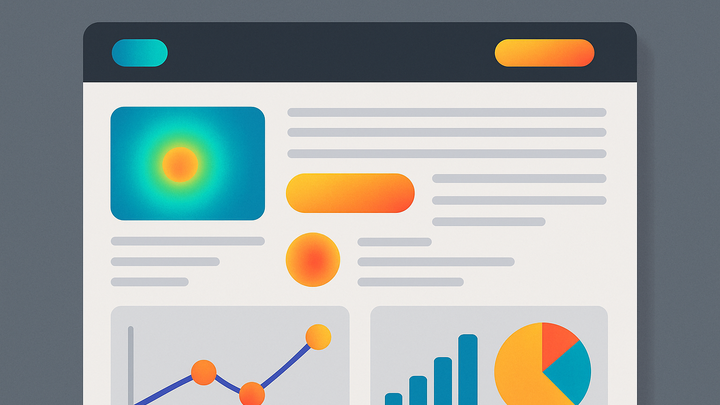Published on 2025-06-22T06:59:34Z
What is a Click Map? Examples for Click Maps
Click Map is a data visualization overlay that displays where users click on a webpage by superimposing colored markers or heat indicators. It helps analysts and designers understand which elements attract attention and interaction, enabling data-driven improvements to usability and layout. Click maps focus exclusively on actual click events, making them more precise than general mouse‐movement heatmaps. By highlighting hotspots and dead zones, they guide optimizations for call-to-action buttons, navigation links, and content placement to boost engagement and conversions. Tools like PlainSignal (a cookie-free analytics platform) and Google Analytics 4 can generate click maps through event tracking and custom configurations. Implementing click maps typically involves adding a small tracking script or enabling Enhanced Measurement in GA4, after which insights appear in an interactive dashboard.
Click map
A visual overlay showing where users click on a webpage to reveal interaction hotspots.
Why Click Maps Matter in Analytics
Click maps provide actionable insights into user behavior by visualizing click distribution. They help identify which content and elements drive engagement and which parts of a page are being overlooked. Understanding click patterns enables teams to make informed decisions about layout, design, and user flow improvements.
-
Usability insights
By highlighting areas with high and low click activity, click maps reveal confusing or non‐intuitive interface elements that may need redesign.
-
Conversion optimization
Analyzing click patterns on calls-to-action helps refine button placement, wording, and design to boost conversion rates.
-
Content engagement
Click maps show which articles, links, or features users find most valuable, informing content strategy and layout improvements.
Implementing Click Maps with Analytics Tools
Click maps can be generated using various analytics platforms, each offering different setup steps and insights. Below is how you can configure click maps in Google Analytics 4 and PlainSignal, a lightweight, cookie-free solution.
-
Google analytics 4 (GA4)
GA4 doesn’t include a native click-map report, but you can approximate one using event tracking and the Explorations tool.
-
Enable enhanced measurement
Turn on Enhanced Measurement to automatically track clicks on outbound links, downloads, and site search interactions.
-
Define custom events
Set up custom click events in GA4 for specific elements (buttons, menus) using gtag.js or Google Tag Manager.
-
Create an exploration
Use the Explorations feature (e.g., Path Analysis or Scatter Plot) to visualize click event data by page.
-
-
PlainSignal
PlainSignal offers a straightforward, cookie-free click map feature that requires only a small script addition.
-
Add the tracking code
Insert the following code snippet into your site’s header to start collecting click data:
<link rel="preconnect" href="//eu.plainsignal.com/" crossorigin /> <script defer data-do="yourwebsitedomain.com" data-id="0GQV1xmtzQQ" data-api="//eu.plainsignal.com" src="//cdn.plainsignal.com/plainsignal-min.js"></script> -
View click maps
Log in to your PlainSignal dashboard to see an interactive overlay of click activity, with hotspots updating in real time.
-
Best Practices for Click Map Analysis
To ensure your click-map insights are reliable and actionable, follow these best practices when collecting and interpreting data.
-
Ensure sufficient data
Collect click data over a representative period to avoid misleading patterns from low-traffic days or spikes.
-
Segment by device and browser
Analyze click patterns separately for desktop, mobile, and tablet to optimize responsive designs and touch targets.
-
Combine with other metrics
Cross-reference clickmap data with session recordings, heatmaps, and conversion metrics for a more complete understanding.
